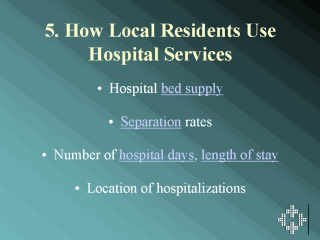| front |1 |2 |3 |4 |5 |6 |7 |8 |9 |10 |11 |12 |13 |14 |15 |16 |17 |18 |19 |20 |21 |22 |23 |review |
 |
These four
indicators are important in helping planners determine: - The relationship between the health status and hospital use for their residents - The ability of residents who need hospital care to access it. For example, researchers in Saskatchewan 9 used hospitalization and vital statistics data (1990-1996) to determine if the loss of a local hospital due to funding cuts (1993) affected hospital use or residentsí health status. Results: The funding cuts to small hospitals did not adversely affect rural residentsí health status or their access to health services. Despite fears about their health, residents reported that the cuts did not affect their health. These findings highlight the value of relevant, timely, and comprehensive information to both consumers and providers of health services. Questions for Planners 1. Do the levels of hospital use levels make sense given the health status of the regionís residents? 2. Is the frequency of hospital use indicative of the residentsí health status or the availability of hospital beds? 3. Are the various facilities being used appropriately and efficiently? |